Intel NUC 13 Pro Arena Canyon Review: Raptor Lake Brings Incremental Gains
by Ganesh T S on March 27, 2023 9:00 AM ESTHTPC and Digital Signage Credentials
The 2022 Q4 update to our system reviews brings an updated media playback evaluation suite for systems. After doing away with the evaluation of display refresh rate stability and Netflix streaming evaluation, the local media playback configurations have also seen a revamp. This section details each of the workloads processed on the Intel NUC13ANKi7 (Arena Canyon).
YouTube Streaming Efficiency
YouTube continues to remain one of the top OTT platforms, primarily due to its free ad-supported tier. Our HTPC test suite update retains YouTube streaming efficiency evaluation as a metric of OTT support in different systems. Mystery Box's Peru 8K HDR 60FPS video is the chosen test sample. On PCs running Windows, it is recommended that HDR streaming videos be viewed using the Microsoft Edge browser after putting the desktop in HDR mode.
The GPU in Intel NUC13ANKi7 (Arena Canyon) supports hardware decoding of VP9 Profile 2, and we see the stream encoded with that codec being played back. The streaming is perfect, thanks to the powerful GPU and hardware decoding support - the dropped frames observed in the statistics below are due to mouse clicks involved in bringing up the overlay.
The streaming efficiency-related aspects such as GPU usage and at-wall power consumption are also graphed below.
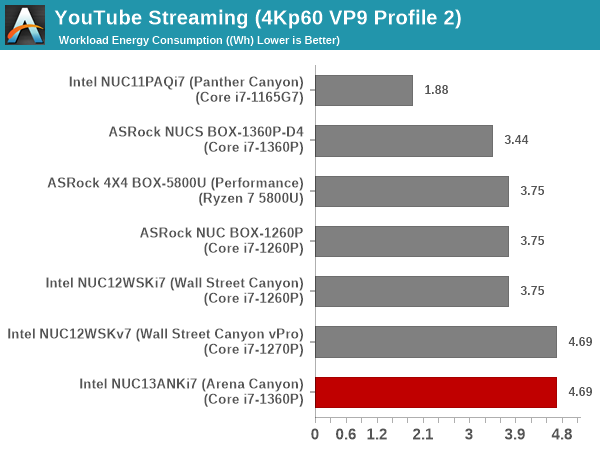
Energy consumption is a bit of a mixed bag, with the Arena Canyon NUC turning out to be the worst of the lot. It is possible that the iGPU drivers are to blame, but we do not see the issue in other playback workloads.
Hardware-Accelerated Encoding and Decoding
The transcoding benchmarks in the systems performance section presented results from evaluating the QuickSync encoder within Handbrake's framework. The capabilities of the decoder engine are brought out by DXVAChecker.
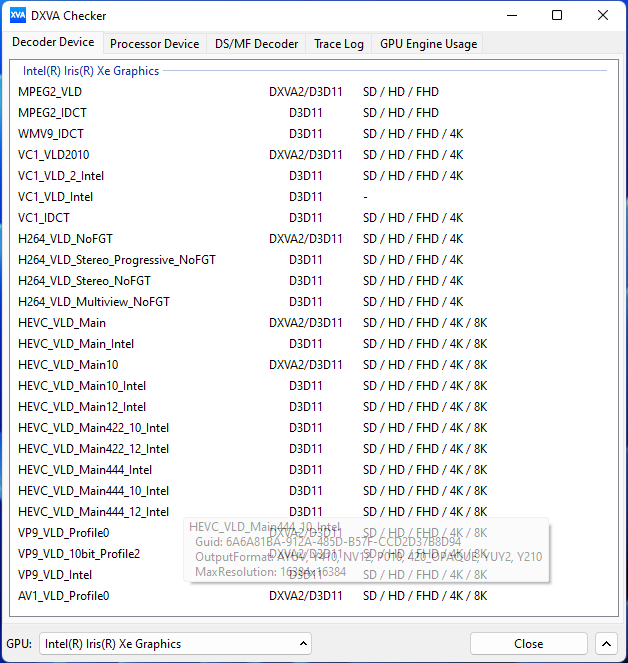
Video Decoding Hardware Acceleration in Intel NUC13ANKi7 (Arena Canyon)
The iGPU in Raptor Lake-P system supports hardware decode for a variety of codecs including AVC, JPEG, HEVC (8b and 10b, 4:2:0 and 4:4:4), and VP9 (8b and 10b, 4:2:0 and 4:4:4). AV1 decode support is also present. This is currently the most comprehensive codec support seen in the PC space.
Local Media Playback
Evaluation of local media playback and video processing is done by playing back files encompassing a range of relevant codecs, containers, resolutions, and frame rates. A note of the efficiency is also made by tracking GPU usage and power consumption of the system at the wall. Users have their own preference for the playback software / decoder / renderer, and our aim is to have numbers representative of commonly encountered scenarios. Our Q4 2022 test suite update replaces MPC-HC (in LAV filters / madVR modes) with mpv. In addition to being cross-platform and open-source, the player allows easy control via the command-line to enable different shader-based post-processing algorithms. From a benchmarking perspective, the more attractive aspect is the real-time reporting of dropped frames in an easily parseable manner. The players / configurations considered in this subsection include:
- VLC 3.0.18
- Kodi 20.0b1
- mpv 0.35 (hwdec auto, vo=gpu-next)
- mpv 0.35 (hwdec auto, vo=gpu-next, profile=gpu-hq)
Fourteen test streams (each of 90s duration) were played back from the local disk with an interval of 30 seconds in-between. Various metrics including GPU usage, at-wall power consumption, and total energy consumption were recorded during the course of this playback.
All our playback tests were done with the desktop HDR setting turned on. It is possible for certain system configurations to automatically turn on/off the HDR capabilities prior to the playback of a HDR video, but, we didn't take advantage of that in our testing.
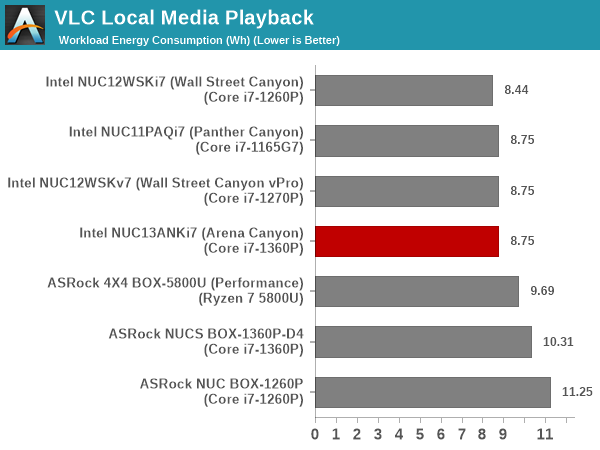
Playback was perfect for all codecs except AV1 (the CPU is not strong enough for software-only 8Kp60 decoding). Power consumption numbers are reasonable, and help the Arena Canyon NUC land up in the middle of the pack.

The scenario seen with VLC is replicated in Kodi also. The middle-of-the-pack entry seen in the VLC case makes an appearance here also, with the software decoding attempt for AV1 being one of the main causes for the spike in the energy numbers.
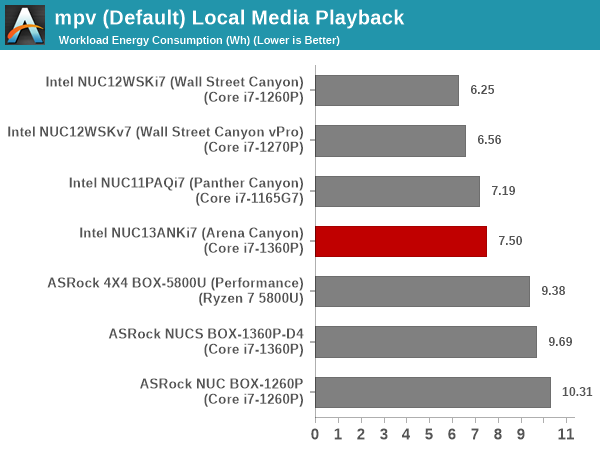
mpv playback with the gpu-next video output driver is the most energy efficient of the lot. We also have hardware accelerated decode for AV1. However, the playback for that clip still has issues, with approximately 60% of the frames getting dropped in the video output (the decoder itself doesn't drop any frames).
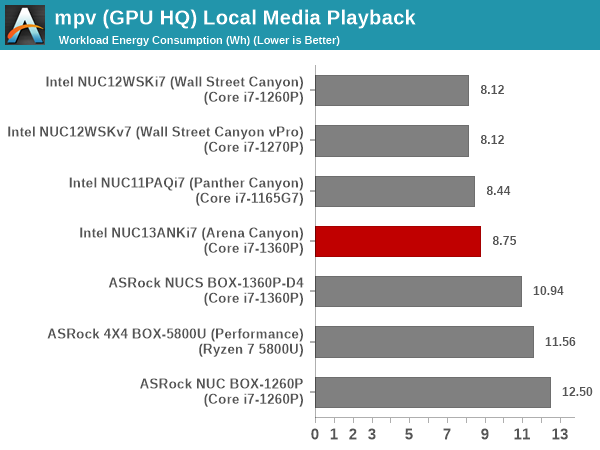
Activating the GPU shaders for video post processing does result in increased energy consumption, but there are no dropped frames. The 8Kp60 AV1 decode video output issue remains the same irrespective of the profile used.


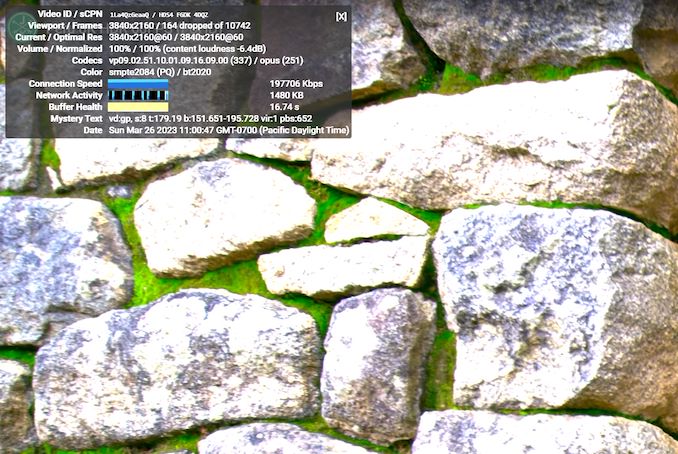

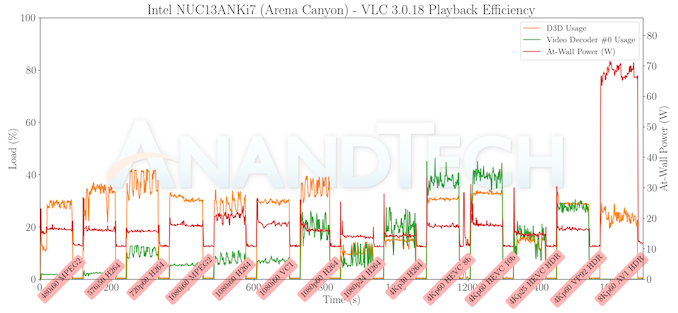

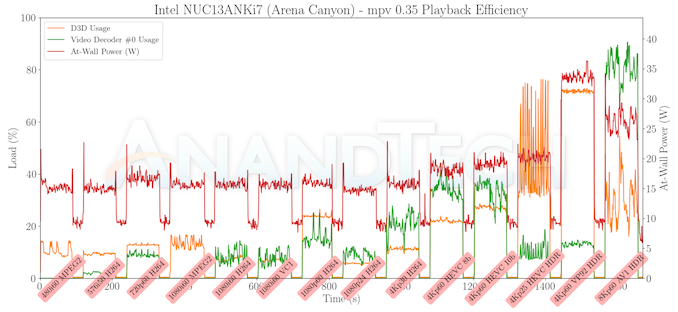
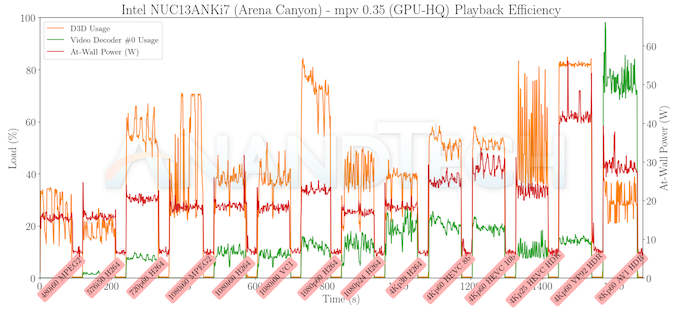








46 Comments
View All Comments
PeachNCream - Tuesday, March 28, 2023 - link
I congratulate you. Your bait caught a lot of them this time. And, like a true troll, you didn't waste keystrokes doing it. Though, admittedly, computer enthusiasts are low hanging fruit that get riled up with minimal work.MrCommunistGen - Monday, March 27, 2023 - link
I'm pretty pleased that there are P-series chips and not just U-series - as many (but not all) previous SFF NUCs used 15W TDP chips rather than 28W and higher TDP mobile CPUs. As long as the cooler can handle the heat load and isn't too terribly loud (or can have its performance/fan curves adjusted) then this could be a really cool SFF PC.I currently have a NUC8i7BEH i7-8559U (28W 4c/8t + eDRAM) which I'm not YET looking to upgrade, but this new 13th Gen NUC is the first model that's gotten me excited about a new NUC in this form factor.
Samus - Tuesday, March 28, 2023 - link
I agree. The P-series was a solid move on Intel's part to stay competitive against Ryzen mobile parts. Even though most notebooks don't seem to utilize the TDP Up (if its a thin plastic laptop kiss PL2 goodbye entirely) the single-threaded boost performance is above U-series parts, and general workflow at low-loads benefit from the stronger E-core headroom. Intel competitively prices the P chips against the U chips as well, which is why you see them in cheaper laptops.abufrejoval - Tuesday, March 28, 2023 - link
The latest U-series to me represent an attempt to have at least a toenail in a fully passive market and that's not an economy niche, even if Intel can put more of them on a wafer: sometimes Intel is strangely insensitive to wasting die area!And since NUCs have always used active cooling even for their Atom models, U-series SoCs simply have no business there.
I am also a fan of the great NUC fan curves, because they allow you to achieve unobtrusiveness, which is only beaten by "never need cleaning out fans and grills", but not at the price of crippled performance or an Akasa case.
I have the same NUC and it's younger cousins, a hexacore NUC10 and a Tiger Lake NUC11. And that last "custom Apple" SoC with the Iris 655 iGPU in the i7-8559U spends more than half its die area on an iGPU that Intel never charged for, but mostly because it didn't actually pay of in performance.
The Tiger Lake trounces NUC8 and 10 by 25% on scalar peformance while the 6 cores of Gen10 and 4 cores of Gen11 draw even on multicore.
The Tiger Lake's 96EU Xe iGPU puts the Iris 48EU iGPU to shame, which only gets 50% performance increase over an 24EU iGPU from the NUC10 for twice the EUs and without needing the eDRAM, which doesn't help nearly as much as it must have cost in production. It marks the turning point for Apple, which wanted much more GPU power at mobile power budgets.
Yes, you can expect a tempting performance uplift from one of these, should you make the switch. But a gaming engine it won't be, because 4x the speed of a lame duck is still pretty lame.
ekon - Monday, March 27, 2023 - link
I like the multitasking benchmarks; don't see that attempted very often as it's not an off-the-shelf test and involves the time and risk of coming up with your own methodology, but it's teased out some interesting results.cruiseliu - Monday, March 27, 2023 - link
Kinda surprised it's still DDR4.Samus - Tuesday, March 28, 2023 - link
I was surprised to see that too. Even 6 months ago I wouldn't be since DDR5 SODIMMs were still elusive unicorns but nowadays they are plentiful and price competitive with DDR4. I've seen 32GB 16x2 kits of Crucial DDR5 5200(?) SODIMMs from B&H for $100 shipped yet nothing mobile seems to take DDR5, and if it does, it's non-upgradable (looking at you XPS 13)Fenturi - Tuesday, March 28, 2023 - link
U690 6800hx based with swappable ddr5MrCommunistGen - Tuesday, March 28, 2023 - link
Me too. I was going to write a follow-up comment about that, but then got a bit derailed writing my anti-rant comment.I suspect that the re-use of DDR4 was a cost saving measure so that they could (mostly) re-use the memory traces, etc from previous NUC boards instead of having to rework that for DDR5.
DDR5 doesn't help all workloads, particularly at JEDEC speeds, but there's definitely some where it helps. Having that little bit of extra performance in this form factor would be appreciated.
Einy0 - Tuesday, March 28, 2023 - link
In response to all the Mac mini comments. I've wanted to dip my toe into the OSX pond for a while now. I do some moonlighting for a business that uses a lot of Macs, and I feel like more hands on time with a Mac would be useful. The ancient Macbook own gives me some exposure but a lot was changed since OSX 10.6.8 . I just can't bring myself to get a mini with only 8GB or RAM. My Macbook has 4GB and a decent SSD and it is SLOW! I imagine newer versions of OSX are more memory hungry, like everything else. I also WILL NOT pay $200 more for $25 worth of RAM. It is plain insulting! Shame on Apple...